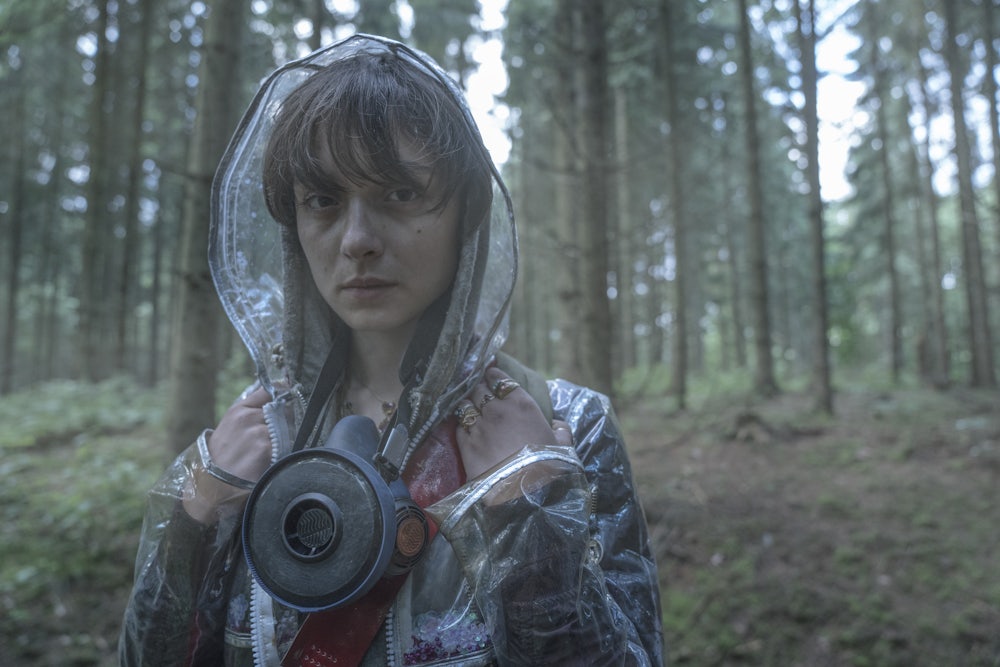Fear produced by the familiar is a different animal. Fear of the unfamiliar—an alien, say, or a sudden explosion—is easy to come by on screen. But familiar fear is the pure uncanny. Movies about loved ones who turn bad, like Orphan, What Lies Beneath, or Fatal Attraction, are terrifying because the evil of the film’s universe has betrayed a social contract. A deal has been struck with the heart, then broken.
The premise of The Rain—Netflix’s first prestige Scandinavian series—is simple and deeply scary: Some biological event has occurred, and now the rain will kill you. Two Danish siblings, Simone and Rasmus, have survived alone in a bunker underground for six years. When they finally run out of food the pair are forced to try their luck at the surface of the earth. Ravaged by death and a serious food shortage, their patch of Denmark has become a Walking Dead-esque gauntlet. After teaming up with a gang of other young people, the siblings journey towards uncovering the cause of the disaster.
Rain is difficult to escape; turning it deadly makes for good plot architecture. Death could come in a single drop seeping through a ceiling, or it could torrent down in an obliterating flood. The Rain runs on a horror of the weaponized familiar, as uncanny as a husband suddenly turned evil. As in the best episodes of Black Mirror, or the shot in Blue Velvet where the camera descends to show the horror that seethes under the perfect lawn, the environment in which the characters live is thoroughly infected by death.
Screenwriter Jannik Tai Mosholt, who also worked on the legendary Borgen, has said, “Civilization is very fickle. It’s a thin layer spread out over thousands of years of basic survival.” The question that The Rain raises is what remains “when civilization is stripped away in an instant.” Mosholt contrasts the show’s apocalyptic feel with Danish aesthetics. He was excited to thrust the cast into “a post-apocalyptic Scandinavia, where all the straight lines of the controlled North have shattered, and let uncontrolled nature take over everything.”
In Mosholt’s telling, The Rain sounds like a bucket of water thrown over an Ikea showroom. But “uncontrolled nature” is not quite the same as a cloud infected by a killer virus. Instead, the deadly environment of The Rain calls back to Tarkovsky’s Stalker, about a dangerous and uninhabited area—the Zone—where every tuft of grass threatens a hidden profundity. Indeed, there are several Tarkovsky-esque elements in The Rain, recalling his obsession with loneliness and the relationship between human beings under duress: Bunker hideouts resemble the craft of Solaris, while a quarantine zone the characters stumble upon clearly calls back to Stalker. “Right now, the zone feels like our place,” one survivor says. The tough little gang are trying to find their way out of the zone, but they also feel a strong attachment to the place and its bent rules, its magical desolation.
Atmospheric shots of treetops waving against a gray sky; blue light and bunker minimalism; hazmat suits and deadly lakes—the environment of The Rain is a gorgeous poem. Other production elements are less even. As several reviews have noted, the show’s soundtrack is invasive. Pop songs play loudly at crucial moments. All the show’s chief characters are young, so the music works up a theme of youthful hope. But the actual setting is supposed to be nearly silent, and the constant noise undercuts the show’s potential menace.
The plot is another problem. Although the premise is an unusual one, the more we learn of the causes and solutions to the problem, the less it makes sense. Because this is not Stalker, we do not quite buy the show as a speculative and magical project. Instead, it has the flavor of a teen horror mystery. Though the tension remains throughout, The Rain walks a difficult line between the fantastical and the realist, and with every episode the plot loses steam.
Stalker was re-released last year in a new restoration. It felt like perfect timing, because our world is edging ever closer to irrecoverable disaster. Climate change is the kind of horror that has few jump-scares: Instead, like a long and meditative film, our planet slides into chaos. With its clear environmental parable, The Rain could have been a new Stalker for our time. But in its disappointing production, perhaps imposed upon it by Netflix’s glossy TV machine, it never quite gets there. In the end, the show does not meet its own promise—it’s a damp squib, not a downpour.
